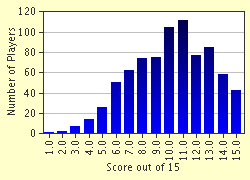Quiz Answer Key and Fun Facts
1. Which of the following clefs would be most appropriate for instruments with a higher pitch?
2. How many half steps are contained within the octave?
3. Which of the following statements about the Major scale is NOT TRUE?
4. Which of the following keys is the parallel minor to C Major?
5. Which of the following keys is the relative minor to B Major?
6. Which of the following keys has 4 flats in its key signature?
7. What effect does a sharp have when placed in front of the note G?
8. In 6/8 time, what is most commonly the rhythmic value of 1 beat?
9. What is the best one word definition for the term "staccato"?
10. Which of the following sonorities would be an example of a major triad?
11. Which of the following choices best describes the intervallic makeup of a diminished triad?
12. Which of the following best describes the relationship between the pitches G-sharp and A-flat?
13. In your music, you see "8vb" written over a section of that music. What does "8vb" mean?
14. The harmonic minor scale differs from the natural minor scale in which of the following ways?
15. The main reasons why music theory is included in undergraduate music curricula are to torment freshmen and to dissuade them from majoring in music.
Source: Author
bmrsnr
This quiz was reviewed by FunTrivia editor
Bruyere before going online.
Any errors found in FunTrivia content are routinely corrected through our feedback system.

